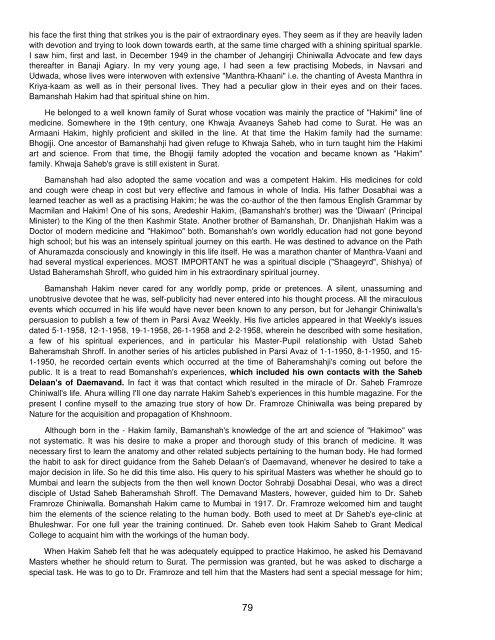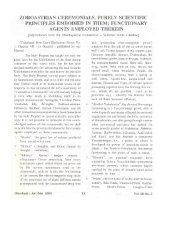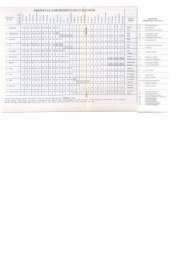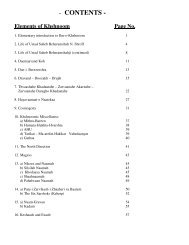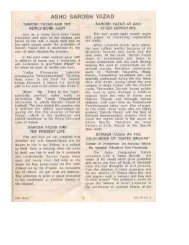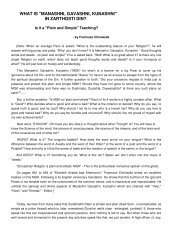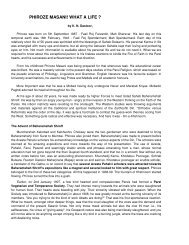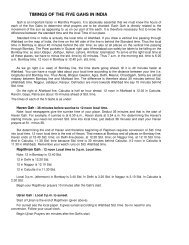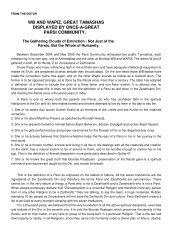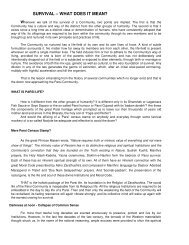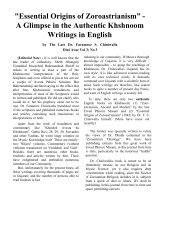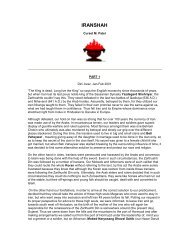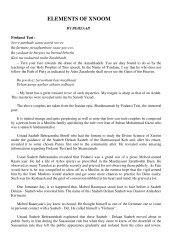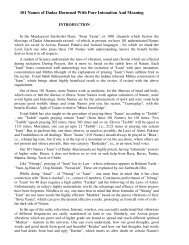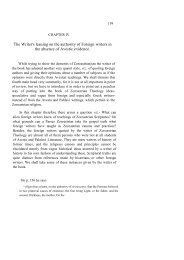Ilm-e-Khshnoom - Traditional Zoroastrianism: Tenets of the Religion
Ilm-e-Khshnoom - Traditional Zoroastrianism: Tenets of the Religion
Ilm-e-Khshnoom - Traditional Zoroastrianism: Tenets of the Religion
You also want an ePaper? Increase the reach of your titles
YUMPU automatically turns print PDFs into web optimized ePapers that Google loves.
his face <strong>the</strong> first thing that strikes you is <strong>the</strong> pair <strong>of</strong> extraordinary eyes. They seem as if <strong>the</strong>y are heavily laden<br />
with devotion and trying to look down towards earth, at <strong>the</strong> same time charged with a shining spiritual sparkle.<br />
I saw him, first and last, in December 1949 in <strong>the</strong> chamber <strong>of</strong> Jehangirji Chiniwalla Advocate and few days<br />
<strong>the</strong>reafter in Banaji Agiary. In my very young age, I had seen a few practising Mobeds, in Navsari and<br />
Udwada, whose lives were interwoven with extensive "Manthra-Khaani" i.e. <strong>the</strong> chanting <strong>of</strong> Avesta Manthra in<br />
Kriya-kaam as well as in <strong>the</strong>ir personal lives. They had a peculiar glow in <strong>the</strong>ir eyes and on <strong>the</strong>ir faces.<br />
Bamanshah Hakim had that spiritual shine on him.<br />
He belonged to a well known family <strong>of</strong> Surat whose vocation was mainly <strong>the</strong> practice <strong>of</strong> "Hakimi" line <strong>of</strong><br />
medicine. Somewhere in <strong>the</strong> 19th century, one Khwaja Avaaneys Saheb had come to Surat. He was an<br />
Armaani Hakim, highly pr<strong>of</strong>icient and skilled in <strong>the</strong> line. At that time <strong>the</strong> Hakim family had <strong>the</strong> surname:<br />
Bhogiji. One ancestor <strong>of</strong> Bamanshahji had given refuge to Khwaja Saheb, who in turn taught him <strong>the</strong> Hakimi<br />
art and science. From that time, <strong>the</strong> Bhogiji family adopted <strong>the</strong> vocation and became known as "Hakim"<br />
family. Khwaja Saheb's grave is still existent in Surat.<br />
Bamanshah had also adopted <strong>the</strong> same vocation and was a competent Hakim. His medicines for cold<br />
and cough were cheap in cost but very effective and famous in whole <strong>of</strong> India. His fa<strong>the</strong>r Dosabhai was a<br />
learned teacher as well as a practising Hakim; he was <strong>the</strong> co-author <strong>of</strong> <strong>the</strong> <strong>the</strong>n famous English Grammar by<br />
Macmilan and Hakim! One <strong>of</strong> his sons, Aredeshir Hakim, (Bamanshah's bro<strong>the</strong>r) was <strong>the</strong> 'Diwaan' (Principal<br />
Minister) to <strong>the</strong> King <strong>of</strong> <strong>the</strong> <strong>the</strong>n Kashmir State. Ano<strong>the</strong>r bro<strong>the</strong>r <strong>of</strong> Bamanshah, Dr. Dhanjishah Hakim was a<br />
Doctor <strong>of</strong> modern medicine and "Hakimoo" both. Bomanshah's own worldly education had not gone beyond<br />
high school; but his was an intensely spiritual journey on this earth. He was destined to advance on <strong>the</strong> Path<br />
<strong>of</strong> Ahuramazda consciously and knowingly in this life itself. He was a marathon chanter <strong>of</strong> Manthra-Vaani and<br />
had several mystical experiences. MOST IMPORTANT he was a spiritual disciple ("Shaageyrd", Shishya) <strong>of</strong><br />
Ustad Baheramshah Shr<strong>of</strong>f, who guided him in his extraordinary spiritual journey.<br />
Bamanshah Hakim never cared for any worldly pomp, pride or pretences. A silent, unassuming and<br />
unobtrusive devotee that he was, self-publicity had never entered into his thought process. All <strong>the</strong> miraculous<br />
events which occurred in his life would have never been known to any person, but for Jehangir Chiniwalla's<br />
persuasion to publish a few <strong>of</strong> <strong>the</strong>m in Parsi Avaz Weekly. His five articles appeared in that Weekly's issues<br />
dated 5-1-1958, 12-1-1958, 19-1-1958, 26-1-1958 and 2-2-1958, wherein he described with some hesitation,<br />
a few <strong>of</strong> his spiritual experiences, and in particular his Master-Pupil relationship with Ustad Saheb<br />
Baheramshah Shr<strong>of</strong>f. In ano<strong>the</strong>r series <strong>of</strong> his articles published in Parsi Avaz <strong>of</strong> 1-1-1950, 8-1-1950, and 15-<br />
1-1950, he recorded certain events which occurred at <strong>the</strong> time <strong>of</strong> Baheramshahji's coming out before <strong>the</strong><br />
public. It is a treat to read Bomanshah's experiences, which included his own contacts with <strong>the</strong> Saheb<br />
Delaan's <strong>of</strong> Daemavand. In fact it was that contact which resulted in <strong>the</strong> miracle <strong>of</strong> Dr. Saheb Framroze<br />
Chiniwall's life. Ahura willing I'll one day narrate Hakim Saheb's experiences in this humble magazine. For <strong>the</strong><br />
present I confine myself to <strong>the</strong> amazing true story <strong>of</strong> how Dr. Framroze Chiniwalla was being prepared by<br />
Nature for <strong>the</strong> acquisition and propagation <strong>of</strong> <strong>Khshnoom</strong>.<br />
Although born in <strong>the</strong> - Hakim family, Bamanshah's knowledge <strong>of</strong> <strong>the</strong> art and science <strong>of</strong> "Hakimoo" was<br />
not systematic. It was his desire to make a proper and thorough study <strong>of</strong> this branch <strong>of</strong> medicine. It was<br />
necessary first to learn <strong>the</strong> anatomy and o<strong>the</strong>r related subjects pertaining to <strong>the</strong> human body. He had formed<br />
<strong>the</strong> habit to ask for direct guidance from <strong>the</strong> Saheb Delaan's <strong>of</strong> Daemavand, whenever he desired to take a<br />
major decision in life. So he did this time also. His query to his spiritual Masters was whe<strong>the</strong>r he should go to<br />
Mumbai and learn <strong>the</strong> subjects from <strong>the</strong> <strong>the</strong>n well known Doctor Sohrabji Dosabhai Desai, who was a direct<br />
disciple <strong>of</strong> Ustad Saheb Baheramshah Shr<strong>of</strong>f. The Demavand Masters, however, guided him to Dr. Saheb<br />
Framroze Chiniwalla. Bomanshah Hakim came to Mumbai in 1917. Dr. Framroze welcomed him and taught<br />
him <strong>the</strong> elements <strong>of</strong> <strong>the</strong> science relating to <strong>the</strong> human body. Both used to meet at Dr Saheb's eye-clinic at<br />
Bhuleshwar. For one full year <strong>the</strong> training continued. Dr. Saheb even took Hakim Saheb to Grant Medical<br />
College to acquaint him with <strong>the</strong> workings <strong>of</strong> <strong>the</strong> human body.<br />
When Hakim Saheb felt that he was adequately equipped to practice Hakimoo, he asked his Demavand<br />
Masters whe<strong>the</strong>r he should return to Surat. The permission was granted, but he was asked to discharge a<br />
special task. He was to go to Dr. Framroze and tell him that <strong>the</strong> Masters had sent a special message for him;<br />
79


